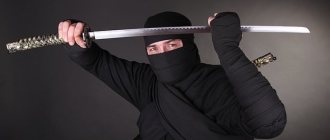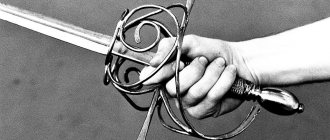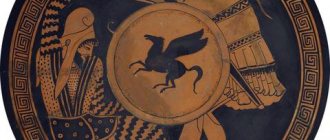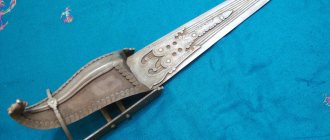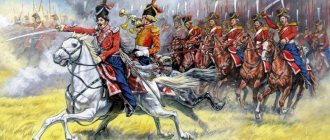In our age - the age of nuclear missiles and digital technologies - the romantic flair does not even think of fading from such beautiful things that have proven themselves over the centuries, such as, for example, the well-known sword - the weapon of the legendary musketeers. The long piercing sword blade was born at the end of medieval chivalry. Turning to ancient history, we learn that the entire “biography” of hand-held bladed weapons began with the sword!
How did Cain kill Abel?
In the Stone Age, people fought - not surprisingly - with stone axes and spears with stone tips - archaeologists have shown the whole world skulls pierced by these weapons. As for cutting meat and cutting skins, flint knives were used for this. It was probably this kind of knife that was first put on a long stick, and it turned into a spear. And the first throwing weapon was an ax, which was attached to a shorter stick. Most likely, it was with a flint knife that our great-ancestor Cain killed our great-ancestor Abel, because they had a quarrel in the field. One could, of course, use a stone for this dirty deed or kill Abel with his own shepherd’s crook, but then the biblical phrase “Cain rose up against Abel” becomes incomprehensible, that is, he rose up against his brother with weapons in his hands. Most likely, in the process of hostile relations that arose between the children of Adam and Eve, Cain used a flint knife - a weapon that was then necessary for both the people of his profession - farmers, and his brother Abel's colleagues - cattle breeders. Then people learned to smelt metal and almost immediately came up with a knife attached to the handle with three transverse rivets. The most ancient metal knives did not have the handle that is familiar to us - included in the handle. However, their blades were not very long, so such a connection was quite strong enough.
The Age of Giants: from the bastard to the flaming flamberge
From about the middle of the 13th century, plate armor became a ubiquitous form of protective equipment for warriors. This led to a further change in the Romanesque sword: it became narrower, the blade received additional stiffening ribs and an even more pronounced tip. By the 14th century, the development of metallurgy and blacksmithing made it possible to turn the sword into a weapon accessible even to ordinary infantrymen. For example, during the Hundred Years' War, a sword of not very high quality cost only a few pence, which was equal to the daily earnings of an archer.
At the same time, the development of armor made it possible to significantly reduce the shield, or even abandon it altogether. Accordingly, now the sword could be taken with both hands and delivered a stronger and more accentuated blow. This is how the bastard sword appeared. Contemporaries called it a “long or combat sword” (war sword), implying that weapons of such length and weight were not carried with them just like that, but were taken exclusively to war. The bastard sword also had another name - “bastard”. The length of this weapon could reach 1.1 meters, and the weight - 2.5 kg, although in most cases the bastard sword weighed about 1.5 kg.
In the 13th century, a two-handed sword appeared on European battlefields, which can be called a real giant among bladed weapons. Its length reached two meters, and its weight could exceed five kilograms. This great sword was used exclusively by infantry, their main purpose being a devastating slash. No sheath was made for such weapons, and they were worn on the shoulder, like a spear or pike.
The most famous two-handed swords are the claymore, zweihander, spandrel and flamberge, which is also called a flaming or curved two-handed sword.
Claymore. Translated from Gaelic, this name means “big sword”. Although, of all the two-handed swords, it is considered the smallest. The length of the claymore ranges from 135 to 150 cm, and its weight is 2.5-3 kg. A special feature of the sword is the characteristic shape of the cross with arms directed towards the tip of the blade. The claymore, along with the kilt and broadsword, is considered one of the most recognizable symbols of Scotland.
Slasher. This is another great two-handed sword that is considered a "classic" of this type of weapon. Its length could reach 1.8 m, and its weight ranged from 3 to 5 kg. The most popular espadon was in Switzerland and Germany. A special feature of this sword was its pronounced ricasso, which was often covered with leather or fabric. In combat, this part was used for additional grip on the blade.
Zweihander. The famous sword of the German mercenaries - Landsknechts. They were armed with the most experienced and powerful warriors who received double pay - doppelsoldners. The length of this sword could reach two meters and weight – 5 kg. It had a wide blade, almost a third of which was unsharpened ricasso. It was separated from the sharpened part by a small guard (“boar’s tusks”). Historians still argue about exactly how the zweihänder was used. According to some authors, it was used to cut the shafts of pikes, others believe that the sword was used against enemy horsemen. In any case, this great two-handed sword can be called a real symbol of the famous medieval mercenaries - the Landsknechts.
Flamberge. A wavy, flaming or curved two-handed sword, so called for the blade's characteristic "wavy" shape. Flamberge was especially popular in Germany and Switzerland in the 15th-17th centuries.
This sword was about 1.5 m long and weighed 3-3.5 kg. Like the Zweihander, it had a wide ricasso and an additional guard, but its main feature was the curves that covered up to two-thirds of the blade. The curved two-handed sword is a very successful and ingenious attempt by European gunsmiths to combine the main advantages of a sword and a saber in one weapon. The curved edges of the blade significantly enhanced the effect of a chopping blow, and a large number of them created a saw effect, inflicting terrible, non-healing wounds on the enemy. At the same time, the end of the blade remained straight, and the flamberge could be used to deliver piercing blows.
The curved two-handed sword was considered an “inhumane” weapon and was banned by the church. However, the German and Swiss mercenaries did not care much about this. True, warriors with such a sword should not have been captured; at best, they were killed immediately.
This great two-handed sword is still in service with the Vatican Guard.
The oldest rapier swords
But then, incomprehensibly where and incomprehensibly why, a certain ancient blacksmith suddenly began to experiment and in exactly the same manner made not a knife, but a sword, and with a long, more than 70 centimeters blade - piercing and diamond-shaped. And from then on things went well! It is known that the ancient Egyptians fought with spears, battle axes and maces made of stone, and instead of swords they had daggers. The Assyrians and Babylonians also used mainly daggers, although they already had short swords. In Europe, this weapon, and it was the long and piercing one, was used by the ancient Irish and Greeks of the Cretan-Mycenaean era. That is, between 1500 and 1100 BC. swords spread very widely. In Ireland, for example, they were discovered in large numbers and are now on display in a number of British museums and in private collections. One of these swords was found right in the Thames. Archaeologists were lucky to stumble upon very similar weapons in Denmark and Crete. There, in Crete and Mycenae, heavier examples of rapier swords were also found - their blades were attached to the handles with rivets. This, it turns out, is what the heroes of the Trojan War fought with - swords about a meter long and two to four centimeters wide! Most of all, they resembled later swords, and such weapons could only be piercing. And here an important question arises: what means of protecting soldiers and methods of armed struggle led to the appearance of a sword of this particular shape?
Do you know that…
According to a common myth, knight's swords weighed more than ten kilograms. In fact, the weight of ancient swords did not exceed more modern swords, rapiers and sabers and weighed only about 1.1-1.4 kg.
Anatomy of a sword: what the weapon consists of
A sword is a type of bladed weapon with a straight, double-edged blade, designed to deliver slashing, slashing and piercing blows. The blade takes up most of the weapon; it can be more suitable for delivering slashing or, conversely, piercing blows.
For the classification of bladed weapons, the shape of the blade and the method of sharpening it are very important. If the blade has a bend, then such a weapon is usually classified as a saber. For example, the well-known Japanese katanas and wakizashi are two-handed sabers. Weapons with a straight blade and one-sided sharpening are classified as broadswords, cutlasses, grand messers, etc. Swords and rapiers are usually classified into separate groups.
Any sword consists of two parts: the blade and the hilt. The cutting part of the blade is the blade, and it ends with a tip. The blade may have a stiffening rib and a fuller, which makes the weapon lighter and gives it additional rigidity. The unsharpened part of the blade near the hilt is called the ricasso or heel.
The hilt of the sword consists of a guard, a hilt and a pommel or pommel. The guard protects the fighter’s hand from impacts against the enemy’s shield, and also prevents it from slipping after a blow. In addition, the cross can also be used to strike; it was actively used in some fencing techniques. The pommel is essential for proper balance of the sword and also prevents the weapon from slipping.
Another characteristic of a sword is the cross-section of the blade. It can be different: rhombic, lenticular, etc. Any sword has two tapers: according to the thickness of the blade and its length.
The center of gravity of the sword (balance point), as a rule, is located slightly above the guard. Although, this parameter can also change.
A few words should be said about such an important accessory as the sword scabbard - the case in which the weapon was stored and transported. Their upper part is called the mouth, and the lower part is called the tip. Sword sheaths were made of wood, leather, and metal. They were attached to a belt, saddle, and clothing. By the way, contrary to popular belief, they did not wear a sword on their back because it was inconvenient.
The weight of the weapon varied within very wide limits: the short gladius sword weighed 700-750 grams, and the heavy two-handed sword weighed 5-6 kg. However, as a rule, a one-handed sword weighed no more than 1.5 kg.
Chopping is better than stabbing!
It turns out that the most serious drawback of ancient European rapier swords was... the rivets. As long as these swords were used only for stabbing, things were good. However, in combat, instinct tells a person to strike the enemy with slashing blows, since this is the most natural movement - to strike a segment of a circle, the center of which is the shoulder. A direct thrust with a piercing rapier or sword is an art that needs to be learned, but, in general, anyone can swing a sword, just like an ax. And on Mycenaean weapons, notches are found, indicating that they not only fencing with swords, but also chopped. But this was precisely impossible to do, because with a side impact, the rivets easily pierced the thin layer of bronze on the shank of the blade (and rapier swords were cast from bronze), as a result of which it broke off from the hilt. That is why, quite soon, stabbing swords appeared, in which the blade with a thin shank formed a single whole, after which the shank was lined with bone, wood or gold plates so as to form a handle that was easy to grip. Such swords were intended to deliver both piercing and slashing blows, and in the late Bronze Age (at least, this is what British sword expert Evart Oakeshott believes) - from 1100 to 900 BC. - such weapons have already spread throughout Europe. But by the middle of the Bronze Age, the shape of swords had changed radically. Now it was no longer a tapering rapier, but a piercing-cutting sword in the shape of a gladiolus leaf, which had a tang behind the blade for attaching parts of the handle. That is, now cutting as a combat technique was used along with a thrust, and the swords themselves became simpler, they were no longer expertly decorated, as was done in an earlier period.
Classification of fighting swords
Combat swords can be divided into several groups depending on the length of the blade, although such a classification is somewhat arbitrary. In accordance with this characteristic, the following groups of swords are distinguished:
- A short sword with a blade length of approximately 60-70 cm;
- A long sword with a blade from 70 to 90 cm. Such a weapon could be used by both foot and horse warriors;
- Swords with a blade length above 90 cm. Most often, such weapons were used by cavalrymen, although there were exceptions - for example, the famous two-handed swords of the late Middle Ages.
According to the grip used, swords can be divided into one-handed, one-and-a-half and two-handed. The one-handed sword had dimensions, weight and balance that made it possible to fencing with one hand; in the second hand the fighter, as a rule, held a shield. A one-and-a-half or one-and-a-half-handed sword could be held with either one or two hands. It should be noted that this term was introduced by weapons experts only at the end of the 19th century; contemporaries did not call these swords that way. The bastard sword appeared in the late Middle Ages and was in use until the middle of the 16th century. A two-handed sword could only be held with two hands; such weapons became widespread after the advent of heavy plate and plate armor. The largest of the combat two-handed swords weighed up to 5-6 kg and dimensions exceeded 2 meters.
The most famous and popular classification of medieval swords was created by the English researcher Ewart Oakeshott. It is based on the shape and design of the weapon's blade. In addition, Oakeshott designed the designs for the crosspieces and pommels. Using these three characteristics, you can describe any medieval sword, bringing it to a convenient formula. Oakeshott's typology covers the period from 1050 to 1550.
Boar tusk helmet and bronze-copper armor
It is quite obvious that everywhere in Europe the first swords were piercing. Proof of this is the Mycenaean, Danish and Irish samples. Then fencing gradually gave way to chopping as a more natural way of fighting that did not require special training, and, as a result, corresponding blades arose. Then fencing almost completely goes out of fashion, and all swords begin to be made with the sole purpose of chopping. Interestingly, the weapons found in Scandinavia show no signs of wear, and the shields are thin and fragile. Did eternal peace really reign there? It turns out that the more we delve into the past, the more professional warriors we find there, although, in theory, it should be the other way around. For some reason, it was the most ancient fighters who used complex fencing techniques on relatively fragile rapiers, while later the warriors slashed with swords with all their might. It is known, however, that the same Mycenaeans went to battle in solid metal armor made of bronze and copper and with shields shaped like a figure eight. It was impossible to pierce them, like the subsequent armor of medieval European knights, but the enemy was quite capable of stabbing a warrior. For example, Mycenaean helmets were made from durable boar tusks, but such headdress did not protect their faces. So the appearance of piercing-cutting swords did not at all mean a regression in military affairs; on the contrary, it testified to the mass character of the warrior profession, and it is the military professionalism of the ancient Irish, Mycenaeans and Cretans that causes genuine delight among modern historians. These ancient peoples, it turns out, were so civilized that they had a military caste, not only protected by armor from head to toe, but also fluent in fencing techniques, whereas in later times every man of the tribe was “conscripted.”
Advantages and disadvantages of the sword
As mentioned above, learning to wield a sword with dignity was very difficult. This required many years of training, constant practice and excellent physical fitness. A sword is the weapon of a professional warrior who has dedicated his life to warfare. It has both serious advantages and significant disadvantages.
The sword is good for its versatility. They can stab, chop, cut, and repel enemy blows. It is suitable for both defensive and offensive combat. Strikes can be delivered not only with a blade, but also with a cross, and even a pommel. However, like any other universal tool, it performs each of its functions worse than a highly specialized tool. You can really stab with a sword, but a spear (at a long distance) or a dagger (at close range) will do it much better. And the ax is more suitable for chopping blows.
The combat sword is perfectly balanced and has a low center of gravity. Thanks to this, the sword is a maneuverable and fast weapon, it is easy to fencing with, you can quickly change the direction of attack, make feints, etc. However, such a design significantly reduces the “armor-piercing” capabilities of the sword: it is quite difficult to cut through even simple chain mail. And against plate or plate armor, the sword is generally ineffective. That is, against an armored enemy, practically only piercing blows can be used.
The undoubted advantages of the sword include its relatively small size. This weapon could be carried with you at all times and, if necessary, instantly used.
As mentioned above, making a sword was a very complex and time-consuming process. It required high qualifications from the master. A medieval sword is not just a strip of forged iron, but a complex composite product, usually consisting of several parts of steel with different characteristics. Therefore, mass production of swords was established only in the late Middle Ages.
"Rapier" is a Spanish word
As for the rapiers and swords, known to us from the books about the three musketeers, they appeared in Spain in the 70s of the 15th century. It was then that the expression “espada de ropera” arose in Spanish literature, which translated means “costume sword,” that is, a sword worn with ordinary clothes (before that they were worn only with armor). The French adopted the word "ropera", also denoting a way of carrying weapons. It was also called “rapier” in England, and “espada” (sword) turned into a sword. Today, both the rapier and the sword are purely sporting weapons, but now we know that it was from the ancient bronze rapier that all later swords came, and after them, swords.
Magazine: Secrets of the 20th Century No. 16, April 2011 Category: History of Weapons Author: Vyacheslav Shpakovsky, Candidate of Historical Sciences, Associate Professor
Tags: Secrets of the 20th century, the Middle Ages, weapons, blade, sword, epee, rapier, dagger, knife
- Back
- Forward
Middle Ages: from the Roman spatha to the knight's sword
After the fall of the Roman Empire, Europe plunged into dark times for several centuries. They were accompanied by the decline of crafts and the loss of many skills and technologies. The tactics of warfare itself were simplified; the Roman legions welded together with iron discipline were replaced by numerous barbarian hordes. The continent plunged into chaos of fragmentation and internecine wars...
For several centuries in a row, armor was almost not used in Europe; only the richest warriors could afford chain mail or plate armor. The situation was similar with the spread of bladed weapons - the sword from the weapon of an ordinary infantryman or horseman turned into an expensive and status item that few could afford.
In the 8th century, the Merovingian sword, which is a further development of the Roman spatha, became widespread in Europe. It got its name in honor of the French royal Merovingian dynasty. It was a weapon designed primarily for slashing. The Merovingian sword had a blade from 60 to 80 cm long, a thick and short crosspiece and a massive pommel. The blade practically did not taper to the tip, which had a flat or rounded shape. A wide and shallow valley stretched along the entire length of the blade, making the weapon lighter. If the legendary King Arthur really existed - which is still debated by historians - then his famous Excalibur should have looked like this.
At the beginning of the 9th century, the “Merovingians” began to be supplanted by the Carolingian type sword, which is often called the Viking sword. Although, these swords were produced mainly on the continent, and they came to the Scandinavian lands as goods or military booty. The Viking sword is similar to the Merovingian, but it is more graceful and thin, due to which it has better balance. The Carolingian sword has a better-defined edge, making it convenient for piercing blows. It can also be added that at the turn of the first and second millennium, metallurgy and metalworking made great progress. Steel became better and its quantity increased significantly, although swords were still expensive and relatively rare weapons.
Starting from the second half of the 11th century, the Carolingian sword gradually turned into a Romanesque or knightly sword. This metamorphosis is associated with changes in the protective equipment of the warriors of the era - the increasing spread of chain mail and plate armor. It was quite problematic to break through such protection with a slashing blow, so a weapon was needed that could effectively stab.
In fact, the Romanesque sword is a huge group of bladed weapons that was in use during the high and late Middle Ages. Compared to the Merovingian sword, the Romanesque sword had a longer and narrower blade with a narrow and deep fuller, noticeably tapering towards the tip. The handle of the weapon also becomes longer, and the size of the pommel decreases. Romanesque swords have a developed hilt, which provided reliable protection for the fighter’s hand - an indisputable sign of the development of the art of fencing of that era. In fact, the variety of swords of the Romanesque group is enormous: weapons of different periods differed in the shape and size of the blade, hilt, and pommel.
